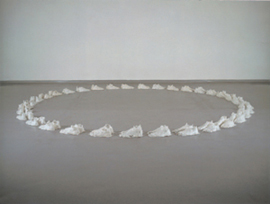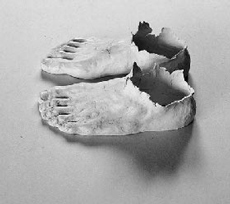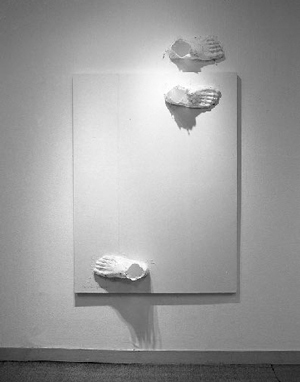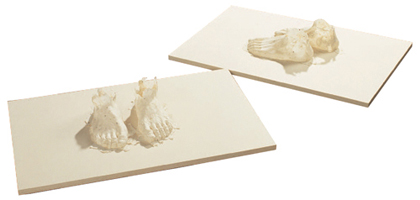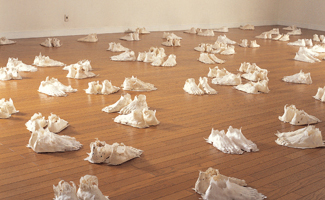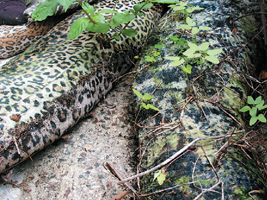|
The following are questions I was frequently asked during several exhibitions in the past. |
||
| q: Your installation exhibition was quite well suited for the 17th century ambience of the Casino Vendramine Palace in Venice. Are you satisfied with it, too? | ||
| a:Of course, I am. At that
time, however, it was difficult for me to anticipate how my works should
be installed in the gorgeous Rococo ambience. Yet, reflecting such unanticipated
conditions into my installation work is also what I find interesting during
the process of my work. |
||
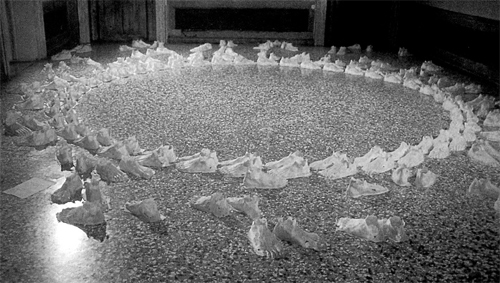 |
||
| q: You seem to have a special preference for paper, a fragile material. Is there any particular reason for that? | ||
a: I hate the ¡®permanency¡¯, which the traditional hard materials of sculpture have. It can be said that the motif of my paper casting works, in particular, was a kind of ¡®fragility¡¯ or ¡®vulnerability¡¯, the nature of the fragile material such as the skin of insects has. The fragile wings of dragonflies can symbolize one essential aspect of life. The theme found in most of my works resembles the life cycle, in that they both are destined to parish in the end. Paper can be reserved for thousands of years. In the mean time, it changes, shrinks, becomes yellow as time goes by, which are also interesting traits reflected in my work. In a way, this is what I wish for. It seems unreasonable and unpleasant to me that artworks would remain ¡®forever¡¯. It is also embarrassing to me to imagine how many years they should enjoy the authority and honor in the courtyard of museums. Then, artworks will end up becoming nothing but a symbol of authority. While, we also need to respect the sensitivity of the next generation of artists. This is why artworks should not be meant to reign over time. What is the difference from pollution, then? It is my view, therefore, that there is a clear distinction that separates the functions of museums from those of art museums. |
||
| q:
Are there institutions that have collections of your art works? I¡¯m curious
how many institutions are going to purchase your works. |
||
a: I don¡¯t want my works to remain for a long time. Most of my works are just installed and displayed, but after the exhibition, almost nothing is left behind. It is becoming difficult for my artworks to be owned by anyone whoever they might be. This raises practical issues, since, this relates to financing for the next works I¡¯m working on. I mean, there is nothing to sell (though my recent paper work may remain). This presents a kind of paradox to me. The artist, Richard Long is selling his works. He is selling a ¡®certificate¡¯ with them. I saw him selling a ¡®document¡¯ with his concepts and ideas. I would like to sell a ¡®trace¡¯ of my works |
||
q: The titles of your works include ¡°Homage to Carl Andre¡± and ¡°Homage to Richard Long¡±. I think that, even though the circular arrangements in your work and that of Long are similar, the process and concepts are quite different. And there was one critic, in fact, whose criticism was that the two are similar. I convinced her that this is not true. What do you think? |
||
| a: First of all, I admire Carl Andre and Richard Long more than any other artists. As for Richard Long, I respect his attitude toward his works and how he deals with them. And I feel that, in some respect, we both share the philosophy. So, I have tried to introduce him in my essays several times. I also dealt with him in my recently published book In-between The Art and The Art Critics. The title ¡°Homage to Carl Andre¡± is my way of expression. To adopt his circular arrangement is also my way of doing work. This might invite misunderstanding in relation to Long, but this is also a way of seeking affinity with him, or a way of understanding of him through my work. I had confidence in trying this, because resemblance in form will reveal effectively where each of us is different. I would not have chosen such a title if I had been worried that this would cause a possible misunderstanding. It was also my intention that this should a way to suggest what I share with them whom I admire. And I found that Andre and I have much in common in our way of thinking. In our preference for horizontal space, for example, it was astonishing to find that he was using terms like ¡®restfulness¡¯ or ¡®calmness¡¯. I, too, see horizontality as implying restfulness-just like hoping to put all those artistic desires to rest, to calm them down. This contemplative view is what Andre learned in Japan. Above all, Long and Andre are the ones who exhibit little heroic gesture unlike many western sculptors. American land artists, in particular, employ heroic gesture and try to confront nature. On the other hand, Long and Andre and Andy Goldwash, in particular, are viewed to be working with contemplative gesture that derives out of awe and reverence of nature, which can be called, in a rather passive way, feminist gesture. This way, they are seeking the conformity with the life cycle of nature. The traditional sculptures of the West have sought heroic and dominant ideology that can be seen, in a sense, as phallicism, in that they desire to rise up against the sky like the Tower of Babel and to dominate the earth below. In contrast, the British artists have sought to restore the calmness of horizontality. This is part of what I try to embody through my work and I wish to ensure such artistic ideas even more. |
||
|
||
q: Is there any particular reason why you chose the foot rather than the face or hand? |
||
| a: That is the question
frequently asked of me. Let me put it this way. The face is dominant part
of our body because facial expression is direct and explicit whether consciously
or unconsciously. On the contrary, the foot displays no mancentered expression
that is overwhelming and dominant. The hand is an active part of our body
we can control. Their function is active and aggressive and their gesture
is sensitive. In contrast, the function of the foot is passive. Because
of this, feet can be seen as the only channel capable of communicating
with nature. This is similar to the roots that lie closest to the earth
and displaying the virtue of Yin and horizontality. And they are anonymous
more than any other part of our body. In this respect, the foot symbolizes
perseverance, fate and ordeal. For Koreans, traditionally, the image of
shoes, which belong to the foot, has been a symbol of life cycle (life
and death) that has affinity with the earth. This way, they connect being
and non-being. Shoes are put on a passageway to death. Those who are going
to drown themselves often put their shoes neatly beside the water, which
is also seen as a ritual symbolizing a departure from this life. In the
Korean traditional funeral, shoes are also used in ¡®sazabap¡¯, a ritual
of bidding farewell to the deceased.Therefore, shoes have been associated
with ¡®departure¡¯, so there is an old custom in Korea not to give shoes
to others as a present. When shoes are taken off, it is done in memory
of the missing and the loss. And as the skin of existence, the surface
of being, they become a metaphor of non-being and departure. What interests
me is that the outer skin implies a departure and circulation and a passage
from being to non-being, and I see that this can be associated with the
foot, rather than with the hand. |
||
|
||
| q: In your last catalog titled ¡°on the meta-pattern¡±, you translated ¡®whehyang-nyeuk¡¯ as ¡®on the meta-pattern¡¯. ¡®whehyang¡¯ is a Buddhist term, yet, in your writings, Taoism is often found. Would you please explain this? | ||
| a: Buddhist terms were translated in the context of Taoism in China. And we need to consider that in China, the Buddhism that we know has been much influenced by Taoism. And ¡®on the metapattern¡¯ is not a direct translation of ¡®whehyang-nyeuk¡¯. When translating, what needs to be considered is ¡®inter-textuality¡¯ as it is now called. So, it might be appropriate to say that this title is not the translation of that, but rather, the two are separate titles. |
||
q: Why did you add ¡®nyeuk¡¯ to ¡®Whehyang¡¯? |
||
| a: ¡®Whehyang¡¯ is much too serious a word, so, I wanted to put some literary sentiment to it. | ||
|
||
q: You use the terms such as ¡®meta form / meta mind¡¯ or ¡®meta sculpture¡¯. Is the word ¡®meta¡¯ here is the same as we use in ¡®metaphysics¡¯? |
||
|
|
||
|
||
My works, in general, seems to remain in the stage before structure and order take shape (diversified), which are conventional organs of works. Works without organs before taking its final form, or those organs not yet diversified -- this is where I often refer to meta, ¡®para¡¯, or ¡®ana¡¯. |
||
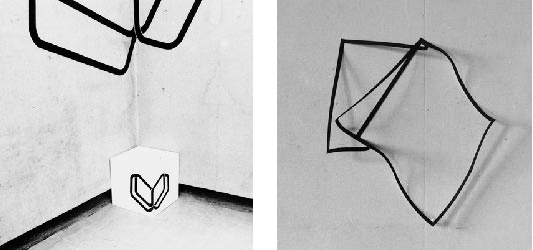 |
||
| [TOP] |
